A) 100%
B) 1 meter per kilometer
C) 15 meters per kilometer
D) 15 kilometers per meter
E) none of these
Correct Answer

verified
Correct Answer
verified
Multiple Choice
What does the associated graph indicate about a stream? 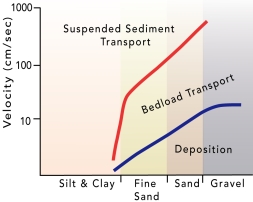
A) Silt and clay are carried in suspension under most stream velocities.
B) Sand and gravel are deposited at low velocities but transported at higher velocities.
C) Sand is carried in suspension only at high velocities.
D) As fast-moving water slows down, fine sand can switch from transport by suspension to the bed load.
E) All of these.
Correct Answer

verified
Correct Answer
verified
Multiple Choice
Which of the following sites is most likely to be flooded if all other factors are held constant?
A) a site that is higher but closer to the river than a site that is lower but farther from the river
B) a site next to the river where the main channel is wider and deeper than other segments of the river
C) a site on the floodplain instead of a site on an older terrace
D) all of these
Correct Answer

verified
Correct Answer
verified
Multiple Choice
Which of these hydrographs shows a flash flood? 
A) A
B) B
C) C
D) D
Correct Answer

verified
Correct Answer
verified
Multiple Choice
What typically happens when tributaries join the main river? 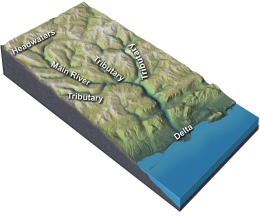
A) channel size increases
B) water velocity increases
C) the amount of discharge increases
D) total sediment load increases
E) all of these
Correct Answer

verified
Correct Answer
verified
Multiple Choice
What would happen if the ice in this area melted away? 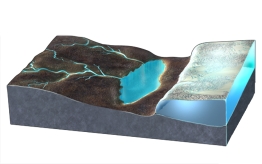
A) the land near the ice would drop due to isostatic rebound
B) rivers could change direction and flow away from the area once covered by ice
C) the land subsides because the ice is removed
D) all of these
Correct Answer

verified
Correct Answer
verified
Multiple Choice
Which of the following is true about how a stream erodes material?
A) abrasion is concentrated on the upstream side of obstructions
B) turbulence of the water is less important than the temperature, which affects viscosity
C) erosion occurs equally on two sides of a bend
D) water cannot erode unless it is carrying sediment
E) all of these
Correct Answer

verified
Correct Answer
verified
Multiple Choice
Smaller subsidiary channels that feed main channels of rivers are called:
A) tributaries
B) drainage systems
C) drainage patterns
Correct Answer

verified
Correct Answer
verified
Multiple Choice
The accompanying figure shows a series of river terraces. Which of these terraces is the oldest? 
A) A
B) B
C) C
D) D
Correct Answer

verified
Correct Answer
verified
Multiple Choice
When water in a stream or desert wash decreases in velocity, sediment that the stream carries can be deposited in:
A) a delta
B) an alluvial fan
C) a floodplain
D) all of these
Correct Answer

verified
Correct Answer
verified
Multiple Choice
What is the mostly likely setting for this drainage pattern? 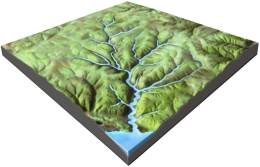
A) the rocks have a relatively equal resistance to erosion
B) drainages have followed a series of fractures that branch off of one another
C) the area has folded or faulted rocks with different resistances to erosion
D) a volcano once existed here but has been partly eroded away
Correct Answer

verified
Correct Answer
verified
Multiple Choice
Which of the following accompanies urbanization replacing farms and open areas with cities) ?
A) the discharge pattern of streams in the area does not change
B) runoff occurs more quickly and produces a higher peak flow
C) runoff becomes more spread out in time, increasing the amount of flooding
D) runoff becomes more spread out in time, reducing the amount of flooding
E) none of these
Correct Answer

verified
Correct Answer
verified
Multiple Choice
Soluble materials in flowing water can be removed and transported by a process called:
A) dissolution
B) tumbling
C) saltation
D) gravity
Correct Answer

verified
Correct Answer
verified
Multiple Choice
Which event is best represented by the hydrograph shown here? 
A) a summer thunderstorm
B) a very long period of steady light rain
C) a long drought with no rain for months
D) a winter snowstorm followed by very cold weather
Correct Answer

verified
Correct Answer
verified
Multiple Choice
What happens to a river as it flows through a delta and encounters the sea? 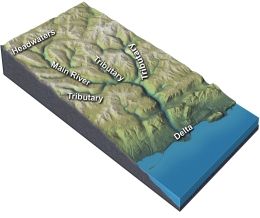
A) the discharge and water velocity increase
B) the maximum sediment grain size carried by the river increases
C) the total sediment load carried by the river decreases
D) all of these
Correct Answer

verified
Correct Answer
verified
Multiple Choice
What is a point bar?
A) A sandbar deposited along the inside of stream meanders due to lower velocity
B) A new, shorter channel across the narrow neck of a meander
C) A crescent-shaped meander cutoff
D) A flowing network of interconnected rivulets around numerous bars
Correct Answer

verified
Correct Answer
verified
Multiple Choice
Deposition in bedrock channels occurs along river banks and behind obstacles as: 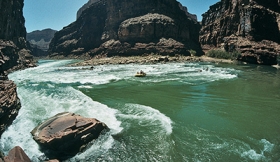
A) water velocity decreases
B) water velocity increases
C) the gradient increases
Correct Answer

verified
Correct Answer
verified
Multiple Choice
A hydrograph shows:
A) the change in a river's discharge over time
B) the beginning and ending elevations of a river
C) the change in the sediment load of a river
D) the length and width of a river
Correct Answer

verified
Correct Answer
verified
Multiple Choice
Where do mountain streams get most of their load of sediment?
A) landslides, slope failures, and erosion of the mountain sides
B) downward incision into bedrock
C) abrasion of bedrock along the bottom of the channel
D) alluvial fans
Correct Answer

verified
Correct Answer
verified
Multiple Choice
This figure shows four numbered river terraces, with 1 being the highest and 4 being the lowest. Which is the oldest terrace? 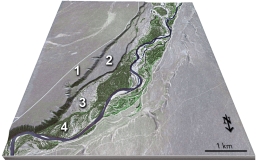
A) 1
B) 2
C) 3
D) 4
Correct Answer

verified
Correct Answer
verified
Showing 61 - 80 of 137
Related Exams